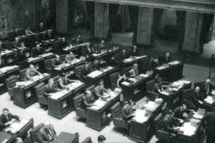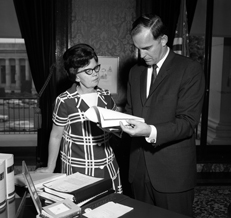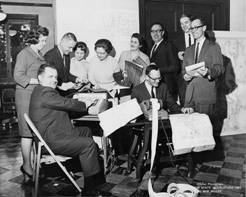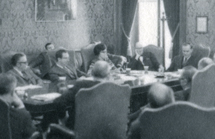Preface
A refreshing government success story: the winners are we the people. Our hero: the democratic process within the system of government designed to serve us all.
Read More…
Prologue
Four encounters between the co-authors lay the groundwork for telling this story as we did. In the fourth, we acknowledge the alarming alienation and disenchantment with politics and government expressed by Mary Ellen’s young adult grandchildren and the generation they represent.
Chapter 1 – THE GAVEL
Citizen participation in a new beginning
 From her seat in the Washington State House of Representatives on her inaugural day in office in 1963, political newcomer Mary Ellen McCaffree (the narrator of our story) leads readers on an ordinary citizen’s tour inside the machinery of representative government. It begins with a literal bang, a surprise coalition and strategic leadership coup that hands a dark horse the Speaker’s gavel.
From her seat in the Washington State House of Representatives on her inaugural day in office in 1963, political newcomer Mary Ellen McCaffree (the narrator of our story) leads readers on an ordinary citizen’s tour inside the machinery of representative government. It begins with a literal bang, a surprise coalition and strategic leadership coup that hands a dark horse the Speaker’s gavel.
As this opening day drama unfolds, the mother of five reflects on her inadvertent path to office, on the issue of inadequate school funding that drove her here, and the enormous reforms she must help propel before she can see it done. Under the eye of the Federal District Court, after being ruled out of compliance with state and federal law, this legislature must redistrict itself or else… the court will. We enter into the process of legislating change.
Chapter 2 – COALITION
Reaching across party lines to break a deadlock
The new coalition – 48 Republicans and 6 Democrats – faces bitter opposition from the remaining 45 Democrats whose majority status has been stripped. Will the coalition hold? The press predicts not. The regular Democrats hope not. After tolerating five days of derision, skepticism and tactical delays, the coalition aggressively asserts its majority status to set the session on its feet, and then gets to work on the task of legislative redistricting.
Because of her citizen role in previous redistricting initiatives, freshman Mary Ellen is named vice-chairman of the House committee assigned to manage the legislative body’s top task. She and the chairman work full time to draft and negotiate dozens of redistricting measures; all are rejected by the Democrat-led Senate. Meanwhile, the coalition adopts procedural reforms to streamline the House and to make their work more accessible to citizens.
Though it fails to strike agreement on redistricting with the Senate, the House coalition successfully blocks each Senate gerrymander that would sustain the status quo. The coalition government, in which Mary Ellen quickly rose, shows how much elected representatives can accomplish when they focus on citizen needs.
Chapter 3 – CHANGING TIMES
Unseating the outdated status quo
 Some suggest Dan Evans should run for governor, since he led the House coalition so well. Mary Ellen is among the handful of “new breed” politicians tackling the state’s problems. They back the prospective governor’s campaign. These like-minded leaders become D.E.G.O.H.T. – the Dan Evans Group of Heavy Thinkers – and they spearhead a grassroots campaign to unseat the longtime incumbent governor and thus gain greater voice. Using skills honed from running a large family, a redistricting initiative, and her own political campaign, Mary Ellen plays a vital role in the long shot gubernatorial run, and helps design the team’s “Blueprint for Progress” – major progressive social reforms paired with fiscal responsibility.
Some suggest Dan Evans should run for governor, since he led the House coalition so well. Mary Ellen is among the handful of “new breed” politicians tackling the state’s problems. They back the prospective governor’s campaign. These like-minded leaders become D.E.G.O.H.T. – the Dan Evans Group of Heavy Thinkers – and they spearhead a grassroots campaign to unseat the longtime incumbent governor and thus gain greater voice. Using skills honed from running a large family, a redistricting initiative, and her own political campaign, Mary Ellen plays a vital role in the long shot gubernatorial run, and helps design the team’s “Blueprint for Progress” – major progressive social reforms paired with fiscal responsibility.
The failure of the ’63 legislature to redistrict ignites legal action. The Federal District Court threatens to nullify existing districts and to throw state legislative seats up for grabs in a statewide free-for-all. Lawsuits lead to a court mandate: the next Legislature may not conduct any business until it has redistricted Washington State. Or else… the courts will do it for them.
Election night sends Dan Evans to the governor’s mansion, and returns Mary Ellen to the House – to a legislature now under court mandate.
Chapter 4 – COMPROMISE
The art of getting to ‘Aye’
After the 1964 elections, House Republicans slip further into the minority, but they have an ally in the governor, and a mandated task – redraw those districts in this ’65 Session. Another dramatic opening day: State law stipulates that new governors aren’t sworn in until the third day of the new session. Thus, Democratic leaders in the House and Senate have 48 hours to ram through their version of redistricting, unchallenged, while their Democratic governor is still in office. A tense two days, but the fractured Democrats finally fizzle. Redistricting will be a bi-partisan task.
Mary Ellen and the Republican redistricting team designs hundreds more proposals, none of them accepted by the legislature as a whole. Intensive negotiation continues for more than a month… between the House and Senate, between Republican and Democrat, until the new governor calls all sides into his office to mediate a tentative solution; the negotiating teams finally resolve it. After 47 days, redistricting is done. With only 13 days left in the 60-day session, the remainder of the state’s business awaits.
Chapter 5 – PERSEVERANCE
Legislating for government reform
 1965 – Undaunted by Democratic control of both the House and the Senate, the governor calls a special session, lays ou t his expectations for the final weeks, presents 35 executive request bills based on the “Blueprint for Progress” and delivers an unprecedented denouncement of his predecessor’s state budget: it is too reliant on federal dollars, and doesn’t support current needs.
1965 – Undaunted by Democratic control of both the House and the Senate, the governor calls a special session, lays ou t his expectations for the final weeks, presents 35 executive request bills based on the “Blueprint for Progress” and delivers an unprecedented denouncement of his predecessor’s state budget: it is too reliant on federal dollars, and doesn’t support current needs.
Mary Ellen continues to pursue solid school funding. She sits on the Ways and Means subcommittee on Revenue, plus committees on Higher Education and Social Security & Public Assistance. Before the legislature are issues ranging from the Blue Laws (no business on Sundays) to budgeting to the possibility of a new state college to affordable health care. Mary Ellen describes the difficulty of processing 700 proposed bills. The session runs a record 114 days. A giant earthquake finally shakes things loose.
Chapter 6 – THE CHALLENGE
Race for the majority on a level playing field
Redistricting gives both parties an equal chance of electing a majority to the House and Senate in this next interim. The coming election season includes a courageous Republican Party stance against infiltration by the extremist John Birch Society. Confronted with balancing family and public service, Mary Ellen must again weigh whether to seek re-election, a decision complicated by her husband’s attractive job offer out of state. In this interim, her activities reflect the varied roles of many legislators: she serves on the Advisory Council on Higher Education that is charged with studying whether the state should build a new four-year college. The governor also appoints her to the interim Tax Advisory Council to study the state’s revenue base. And several incumbents, including Mary Ellen, coordinate the Republican “Campaign School” for new candidates and help recruit more moderates to run. Mary Ellen finally decides to seek re-election herself.
The 1966 general election seats a Republican majority in the House. Governor Dan Evans is still in office, mid-term. For the first time in more than a decade, a new party will lead the state.
Chapter 7 – LEADERSHIP
Tackling the challenging and complex
1967 – As the 40th Session begins, America quakes with protest and unrest. Mary Ellen reflects: the team of leaders she first joined is similarly bent on reform and greater voice, but they are seeking change by working within the system, rather than in the streets. Now with a House majority – 55 to 44 – she and her team are ready to address school funding. Her party enters the session with an ambitious agenda, a streamlined process for legislative work, and a determination to lead. Tax reform is a top ‘Blueprint’ priority, and as new chairman of the House committee on Revenue and Taxation, Mary Ellen is increasingly active in a leadership role: in the committee room, on the House floor, and working in tandem with the governor’s office. A proposed sweeping state overhaul, requiring a large budget increase, means the Revenue and Taxation Committee must assess revenue and find the funds.
Chapter 8 – BLUEPRINT FOR PROGRESS
Legislating for a new direction
 As the 1967 Session continues, legislators work day and night, both in sessions and in public hearings throughout the state – listening to various voices and, in Mary Ellen’s case, sharing the recommendations of the Tax Advisory Council and considering feedback. She helps develop a proposed new tax structure for the state, and eventually presents to the House a tax reform package that calls for a single rate income tax – the state’s first income tax – as a means to steady the revenue base.
As the 1967 Session continues, legislators work day and night, both in sessions and in public hearings throughout the state – listening to various voices and, in Mary Ellen’s case, sharing the recommendations of the Tax Advisory Council and considering feedback. She helps develop a proposed new tax structure for the state, and eventually presents to the House a tax reform package that calls for a single rate income tax – the state’s first income tax – as a means to steady the revenue base.
She is also a member of the House Higher Education committee, which forms a new four-year state college, as recommended by the interim advisory council she vice-chaired. Mary Ellen will be named by the governor to the initial board of trustees.
For the balance of the session, Mary Ellen works on measures ranging from environmental protection to education to specifics of her district constituency. The session ends with a powerful list of enacted laws, plus many more introduced that are taking shape. But the tax reform package fails: insufficient legislator support. A major disappointment.
Chapter 9 – COMMUNITY VOICE
Representing a constituency
 Back home, tax reform receives continuing attention in public hearings and before the Tax Advisory Council. The Interim Legislative Council – to which Mary Ellen has been appointed and where she has agreed to serve as chairman of the Revenue and Regulatory Agencies Committee – is a group that ties up legislative loose ends and works on bills to pre-file in the next session. Mary Ellen’s legislative work veers full time.
Back home, tax reform receives continuing attention in public hearings and before the Tax Advisory Council. The Interim Legislative Council – to which Mary Ellen has been appointed and where she has agreed to serve as chairman of the Revenue and Regulatory Agencies Committee – is a group that ties up legislative loose ends and works on bills to pre-file in the next session. Mary Ellen’s legislative work veers full time.
In another busy interim, Mary Ellen again juggles family responsibilities and legislative work, along with involvement in more political campaigns. University students seek her assistance and advice on how to change the law to give 18-year-olds the right to vote. Her husband, on the Faculty Senate at the University of Washington, also keeps close tabs on the pulse of the young. The campus broils. Vietnam protests escalate. The assassinations of Martin Luther King, Jr. and Robert Kennedy set an already turbulent nation on eggshells. State leaders maintain a responsive, commendable calm. The ’68 election returns Mary Ellen to the House, Evans to the governor’s seat.
Chapter 10 – TAX REFORM
Stabilizing a lopsided revenue base
Mary Ellen’s early “team” has largely graduated to other offices – governor, attorney general, State senate. She now ranks near the top of her House caucus. Her steady aim: statewide tax reform (to better fund schools). She continues as chairman of the House committee on Revenue and Taxation, campaigns extensively on behalf of tax reform, educates colleagues, constituents and various voter groups. The grueling work pays off. Having navigated tough opposition and skepticism, she finally presents a tax reform package that both state houses accept. From the floor of the House, a colleague publicly salutes her: “I would like to have the record show that this House is indeed indebted to a very fine and loyal public servant. The Chairman of the Committee on Revenue and Taxation, though just a mere woman, is a giant as a legislator. As this young lady stood on the floor today and explained this most complex measure in its entirety, I could not help but salute her. I am most proud she is one of ours on this side of the aisle, but at this point she is not just a Republican—she is a legislator. I can’t tell you how proud this body is to claim her as one of its own. Mrs. McCaffree, we are in your debt.”
She receives a rare standing ovation. But other major reforms remain undone even after a regular session and lengthy extra session added on.
Chapter 11 – INCOMPLETE
Disappointment with an unfinished legislative agenda
 The 41st Session ends, leaving leaders with a gnawing feeling of not having accomplished enough, considering so many other major bills were so close to completion at sine die, particularly a host of environmental protections. Will the governor call a special session to finish? Who knows? Many ask Mary Ellen, since she is a close colleague of the governor.
The 41st Session ends, leaving leaders with a gnawing feeling of not having accomplished enough, considering so many other major bills were so close to completion at sine die, particularly a host of environmental protections. Will the governor call a special session to finish? Who knows? Many ask Mary Ellen, since she is a close colleague of the governor.
Vietnam war protests continue, but a new issue emerges on the national scene: environmental protection. In September, the governor convenes a retreat with environmental groups and state leaders. They agree on a list of six key issues, and the governor suggests he may call a special session to tackle these. The economy begins to flag. Massive layoffs ensue. In December, the governor calls another session of the 41st Legislature: to address the environment, and those remaining issues left undone – those that can’t wait another year. Mary Ellen is one of a handful of leaders in charge.
Chapter 12 – EXTRAORDINARY
The government our forefathers designed
An unprecedented second extraordinary session begins in January of 1970, with House leadership joining the governor in a goal of keeping it to 30 days, and sticking to a specific agenda. For the next four weeks, the legislature carries out a thorough, disciplined process of deliberation, compromise and passage of a record number of major pieces of legislation, many of them first identified in the Blueprint for Progress. They also pass several emergency economic stop-gaps, specific to troubled times. After hammering out compromises on many complex reforms over a number of years, the state now adopts measures that address some of the most complex issues of the decade. No one outside the legislature thought it could be done within the 30-day stretch, especially the press. (It actually takes 32.) This is considered the most successful legislative session in Washington State history. An ordinary citizen, Mary Ellen McCaffree played a key role in the legislative effort that paved the way for these historic accomplishments, as she became the lead legislator on some of the more complex issues and reforms.
The crown jewel of this 1970 session is a package of major environmental laws, including establishing a state Department of Ecology (the first state with such a dedicated department, pre-dating the federal EPA).
Other major reforms include:
• Overhaul of the state’s long-ignored and inefficient system of unemployment compensation by closing loopholes, increasing benefits, and establishing a ground-breaking structure
• Approval of a local option sales tax, the first time cities and counties are authorized to fund services locally
• Establishment of a unified Department of Social and Health Services (disentangling overlapped services from five previous departments)
• Strengthening environmental quality controls on air and water pollution, oil spill, strip mining, and nuclear power and expanding the protection of Open Space via ‘current use’ taxation rather than ‘highest and best’ use.
• A constitutional amendment to lower the voting age to 19 years
• Liberalization of the state’s abortion law, leading the nation.
Mary Ellen McCaffree’s state has discarded its stale status quo mode, and has moved to the top of our nation with its progressive policies.
Epilogue
The success of this 1970 Session is largely credited to the pressure applied by the public, and to leaders who put the public before politics and political gain. The elected and electorate shared responsibility. Our government is us – created, defined and sustained by We, the people. The better we understand our governmental process, the better we can keep it on track. “It’s your turn,” Mary Ellen tells her grandchildren now. They’re catching on: the caliber of our communities and our government is up to us.
